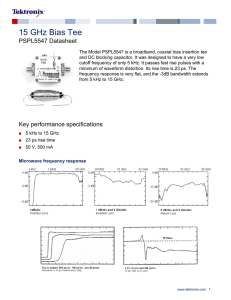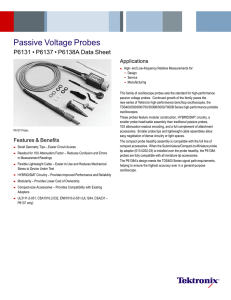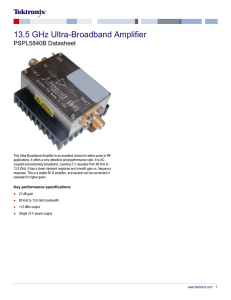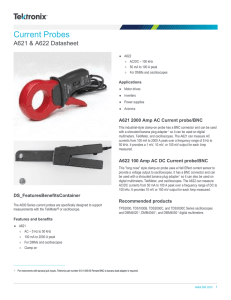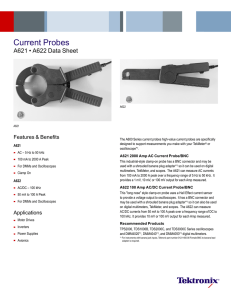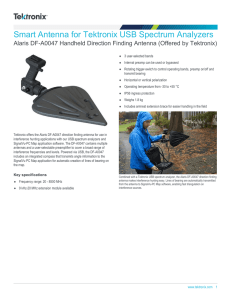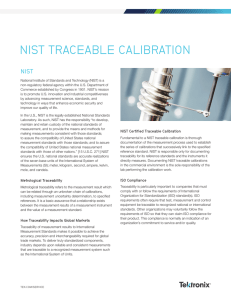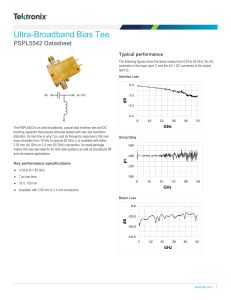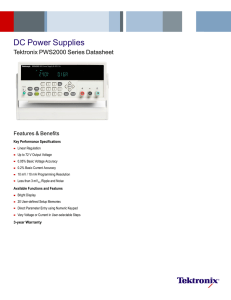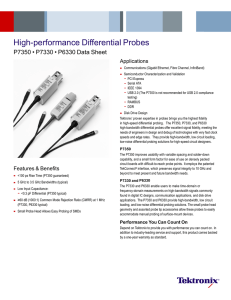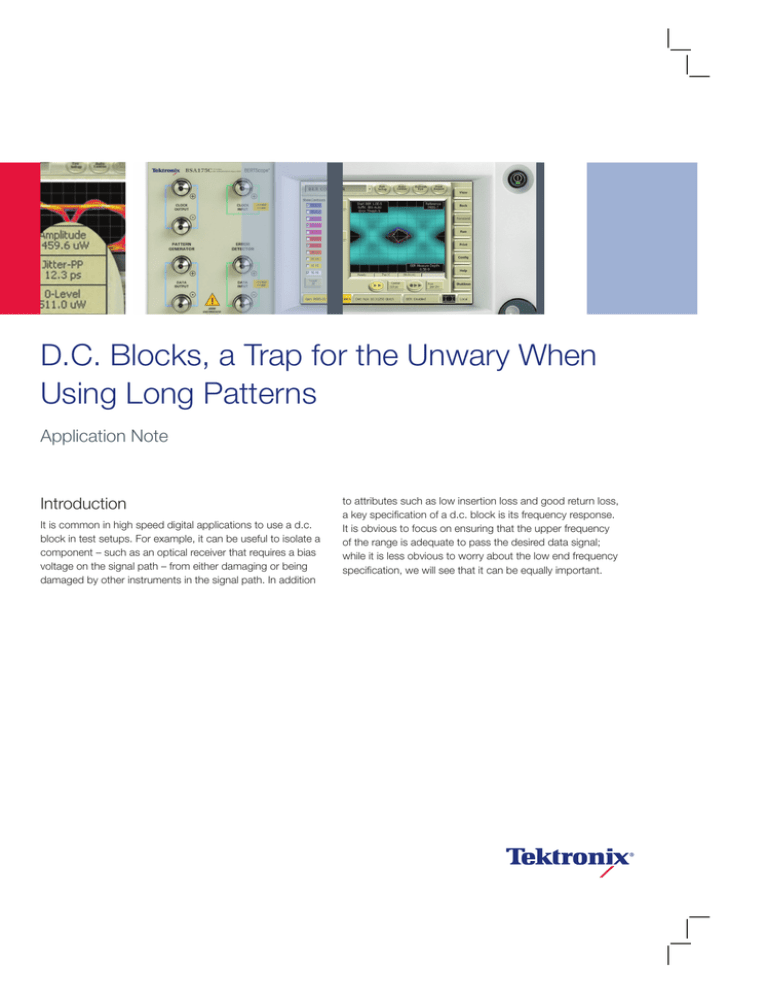
D.C. Blocks, a Trap for the Unwary When
Using Long Patterns
Application Note
Introduction
It is common in high speed digital applications to use a d.c.
block in test setups. For example, it can be useful to isolate a
component – such as an optical receiver that requires a bias
voltage on the signal path – from either damaging or being
damaged by other instruments in the signal path. In addition
to attributes such as low insertion loss and good return loss,
a key specification of a d.c. block is its frequency response.
It is obvious to focus on ensuring that the upper frequency
of the range is adequate to pass the desired data signal;
while it is less obvious to worry about the low end frequency
specification, we will see that it can be equally important.
Application Note
Pattern
Length (bits)
Lowest Frequency
Component for a
10 Gb/s signal
PRBS-7
127
78.7 MHz
PRBS-9
511
19.5 MHz
PRBS-1
12,047
4.9 MHz
PRBS-1
532,767
305 kHz
PRBS-2
38,388,607
1.2 kHz
PRBS-3
12,147,483,647
5 Hz
CJTPAT
2,640
3.8 MHz
Table 1. Lowest frequency components for some common test patterns.
Figure 1. Reminder of an NRZ spectrum, with nulls at multiples of the bit rate, and
sin(x)/x envelope. The minimum frequency and line spacing are both given by the
formula in the text, with examples in Table 1.
Background
A simple rule of thumb is that the lowest frequency contained
in an NRZ spectrum will be around (data rate [in Gb/s]) /(test
pattern length). For example, for a 10 Gb/s signal, a PRBS-7
containing 127 bits will have its lowest frequency component
around 80 MHz. This and other examples are shown in the
table. The frequency we’ve calculated also corresponds with
the line spacing in the spectrum. See Table 1.
As will be obvious by now, a d.c. block that does not have
a low enough frequency cutoff at the bottom end might
attenuate frequency components of a signal involving a longer
pattern, affecting measurement results.
Figure 1 is a reminder of the characteristics of an NRZ data
spectrum. Figure 2 shows two example pattern lengths, as
well as two d.c. blocks (described in the next section), along
with their low end cutoff frequencies.
Figure 2. The minimum frequency in the longest common test pattern, PRBS-31 (a)
is shown alongside one of the commonest short patterns, PRBS-7 (b). The minimum
frequencies of two different models of d.c. blocks (c) and (d) are also shown.
2
www.tektronix.com/bertscope
D.C. Blocks, a Trap for the Unwary When Using Long Patterns
Figure 3. Passing 9.95 Gb/s data using a PRBS-31 pattern. (1) shows the signal after passing through the measurement setup but d.c. coupled; (2) has the better of the two d.c.
blocks in place, (3) has a 5 MHz lower frequency cutoff and shows significant eye degradation.
A Simple Experiment
Conclusion
We ordered two different model d.c. blocks from the same
manufacturer. The two models were:
PRBS-31 is a particularly exacting pattern in many ways.
As demonstrated above, combining such a long pattern
with a d.c. block requires care. Using one that removes
appreciable low end energy can affect system performance
and measurements. (This was learned through bitter practical
experience — much time was wasted trying to track down
the source of unexpected results before realizing it wasn’t the
device under test after all.)
(a) 5 kHz to 23 GHz
(b) 5 MHz to 18 GHz
The maximum frequencies are similar, but there are three
orders of magnitude difference in the low end; 5 kHz
compared with 5 MHz. As can be seen from Figure 2, for
a short pattern such as PRBS-7, both models should be
capable of passing the entire low end of the spectrum;
for PRBS-31 both are likely to clip the low end, but by not
passing appreciable energy below 5 MHz, the second model
d.c. block is likely to be altering the signal in a noticeable
way. The results of the experiment are shown in Figure 3,
with significant closure in the BER Contour observable at low
probabilities. A shallow eye diagram would show negligible
difference, but a real receiver would be negatively impacted by
the block with the higher bottom-end cutoff frequency.
www.tektronix.com/bertscope
3
Contact Tektronix:
ASEAN / Australasia (65) 6356 3900
Austria* 00800 2255 4835
Balkans, Israel, South Africa and other ISE Countries +41 52 675 3777
Belgium* 00800 2255 4835
Brazil +55 (11) 3759 7600
Canada 1 (800) 833-9200
Central East Europe, Ukraine and the Baltics +41 52 675 3777
Central Europe & Greece +41 52 675 3777
Denmark +45 80 88 1401
Finland +41 52 675 3777
France* 00800 2255 4835
Germany* 00800 2255 4835
Hong Kong 400-820-5835
India 000-800-650-1835
Italy* 00800 2255 4835
Japan 81 (3) 6714-3010
Luxembourg +41 52 675 3777
Mexico, Central/South America & Caribbean 52 (55) 56 04 50 90
Middle East, Asia and North Africa +41 52 675 3777
The Netherlands* 00800 2255 4835
Norway 800 16098
People’s Republic of China 400-820-5835
Poland +41 52 675 3777
Portugal 80 08 12370
Republic of Korea 001-800-8255-2835
Russia & CIS +7 (495) 7484900
South Africa +27 11 206 8360
Spain* 00800 2255 4835
Sweden* 00800 2255 4835
Switzerland* 00800 2255 4835
Taiwan 886 (2) 2722-9622
United Kingdom & Ireland* 00800 2255 4835
USA 1 (800) 833-9200
* If the European phone number above is not accessible,
please call +41 52 675 3777
Contact List Updated 25 May 2010
For Further Information
Tektronix maintains a comprehensive, constantly expanding collection of
application notes, technical briefs and other resources to help engineers
working on the cutting edge of technology. Please visit www.tektronix.com
Copyright © 2010, Tektronix. All rights reserved. Tektronix products are
covered by U.S. and foreign patents, issued and pending. Information in this
publication supersedes that in all previously published material. Specification
and price change privileges reserved. TEKTRONIX and TEK are registered
trademarks of Tektronix, Inc. All other trade names referenced are the service
marks, trademarks or registered trademarks of their respective companies.
09/10
EA/WWW
65W-26043-0

